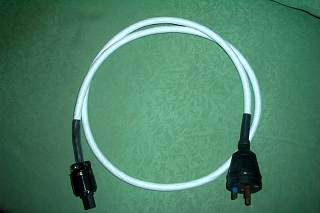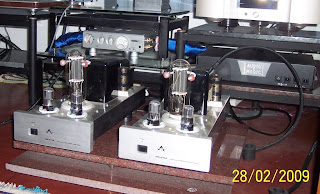 AOR Reference 003, pretty in white.
AOR Reference 003, pretty in white.
Sometime in late July last year, I heard a story about how a local David slayed an American Goliath in the power cord stakes. The myth, apparently pointed out that this locally made RM$1K plus power cord, beat an American branded high end product costing ten times more. The rest they say is history!
Sometime in August last year, I was home visiting our resident LS3/5A guru, Jo Ki and came across this pretty in white looking cable, seemingly made of litz construction. I asked, what's this?, my host reluctantly shared with me that he was helping a friend test and develop this interesting power cord, apparently, designed to work best with Torus Power Conditioners and digital playback equipment, such as DACs and high end CD players.
I gave my dear friend, Felix a call, and asked to try his latest efforts. He told me that he was finalizing production details of his then, yet to be named power cord. Two months later, in October, my sample arrived. I asked, what took him so long?
He told me that to build each power cord consistently, he had to prepare a jig to facilitate the litz construction, the cable's high purity copper cores are sourced from a reliable supplier. All terminations are of silver solder sourced from a well respected high end manufacturer in German. Standard American style male plugs and IEC female side is sourced from Holland. British style male plug is 13 amps MK Duraplug with rubber body(like those usually seen on high end big Krell power amps), not plastic. Standard power cord length available is 1.8M and 2.1M.
But the real secret in shaping AOR Reference 003's final sound, is in the building process. Each termination screw has it's own torgue spec!, as is each plug body screw. To protect the cable outer screws from being mucked around, all screw holes are waxed. Felix further adds that it takes him a little more than 2 days to build a power cord. Each power cord, will sound the same as he not only checks their impedance, resistance and capacitance to spec, he also burns them for a few days, then listens to them on his own system, to ensure all AOR Reference 003 sounds the same. He also tells me, each system only needs one AOR Reference 003, best used with the source, if not pre amp duties is good too. I totally trust his ears!
I plugged the AOR Reference 003 in to my Marantz CD7, replacing the Isotek Premium power cord. The comparison from here on is made between the Isotek Premium and the AOR Reference 003. From the first notes, I was blown away. The Marantz CD7 being a player of slightly mellowed nature, suddenly sounded as if it just completed a 12 week fitness program.
The AOR Reference 003 made the overall sound a little more focus, the level of energy and micro dynamics of the Marantz CD7 was improved considerably. Also improved is the transparency of the CD player, seemingly able to dig out more information out of the CD medium than previously. Low level detail previously masked is now brought to the fore, but ever so naturally and never calls attention to it self.
However, at times I felt the power cord can be just a little more refined and civilised. Not that it's bright or harsh, just wishing that at times when playing music of more mellowed nature, it can just be a little gentler, yes, that's the correct word.
I then proceed to try the AOR Reference 003 on my DIY Pass ONO clone phono stage, and found that it gave the same kind of improvements as per the CD player experienced earlier but only this time, the leap was bigger, much bigger. Not one who does things half way, I called Felix again to request for a second AOR Reference 003 to power my phono stage, again, the wait was another two agonising months!
 The two ends, MK Dura plug and Furutech FI-11(G).
The two ends, MK Dura plug and Furutech FI-11(G).
My wish for a gentler sounding AOR Reference 003 came in the form of the Furutech FI-11(G) IEC female plugs. With the Furutech installed, the experience of the sound was life changing!(refer back to my 8th January 2009 post, A Tale of IEC Plugs) The Furutech maintained all the positive attributes of the AOR Reference 003, but also made improvements the to weaker areas, to make the power cord such a world beater. I called Felix, told him to come listen to his product again with the Furutech, he was impressed, took my two AOR Reference 003, went back and did further studies on the matter.
When returned to me about a week later, he told me that it'll now sound even better! Apparently, all the cable to plug termination screw's torgue spec on the IEC female side have been revised for the Furutech, as well as the amount of silver solder used for that affected end. Now, that's attention to detail! The returned cables are simply magical, giving more airy highs, a little warmer mids, and the killer micro dynamics which I found so amazing, never diluted one bit!
The Furutech FI-11(G) is now a cost added option(take the Furutech option if you're really serious about sound!, IMHO) when buying the AOR Reference 003.
There's a now a 2-3 month's waiting list for this power cord. Felix tells me the waiting list is growing still. He can't make the power cords any faster, as he has to personally make, and test each power cord. Now, if this isn't a custom product worthy of a signature, then I don't know what is!
If you're thinking about spending some serious $$$ on power cords, you owe it to your self to check out the AOR Reference 003.
If interested, you can call Felix to enquire at 012-3662408.

 The multi display indicating batteries 100% charged.
The multi display indicating batteries 100% charged. The multi display indicating system load 36%.
The multi display indicating system load 36%.  Note the big breathing griles for the built in fans. I can hear the fans "whirrrl...ing" away when no music is played.
Note the big breathing griles for the built in fans. I can hear the fans "whirrrl...ing" away when no music is played. The 2 big red JPS Inwall to power the pair of mono blocks. the black cable powers the Isotek Sigmas, which filters and in turn power my CD player, turn table, preamp and phono stage.
The 2 big red JPS Inwall to power the pair of mono blocks. the black cable powers the Isotek Sigmas, which filters and in turn power my CD player, turn table, preamp and phono stage.












































